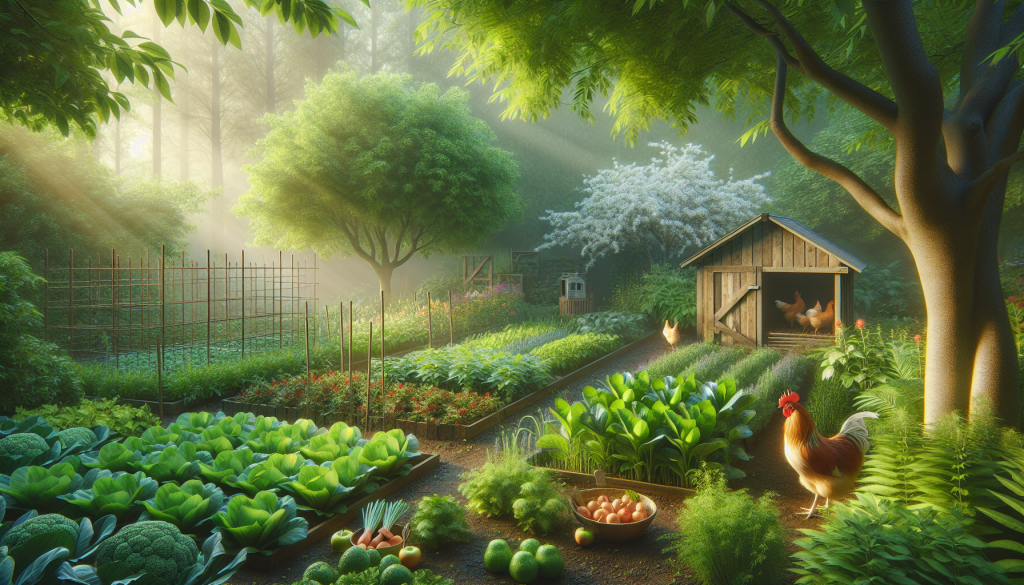
In an age where sustainability and independence are gaining prominence, backyard self-sufficiency has emerged as a goal for many. As people increasingly strive to reduce their reliance on external resources, creating a self-sufficient backyard offers a promising path to fulfilling this ambition. By combining gardening and raising chickens, you can transform your backyard into a productive, sustainable hub that provides food, reduces waste, and supports a healthier lifestyle.
Understanding Backyard Self-Sufficiency
At its core, backyard self-sufficiency aims to create a space that produces the essential resources needed for a household—such as food, water, and sometimes even energy—with minimal reliance on external inputs. This approach not only helps in reducing costs but also cultivates a deeper connection with nature and promotes a more sustainable lifestyle. While large spaces lend themselves well to expansive gardens and larger-scale operations, even backyards with limited space can be optimized for self-sufficiency through thoughtful planning and efficient practices.
The Role of Gardening
Gardening is a cornerstone of backyard self-sufficiency. A well-planned garden can provide a substantial portion of the vegetables, herbs, and fruits you consume, lowering your grocery bill and ensuring fresher produce. To start, assess the sunlight, soil type, and space available in your backyard. Raised beds or vertical gardens are excellent solutions for smaller spaces, maximizing yield efficiently.
Select a variety of crops that cater to your dietary needs and preferences. Implementing succession planting—where you plant new crops as soon as old ones are harvested—can extend your growing season and increase production. Composting kitchen scraps and garden waste creates nutrient-rich soil, reducing the need for chemical fertilizers and promoting a healthy ecosystem. Collecting rainwater in barrels provides a sustainable water source to nourish your garden without increasing utility bills.
Incorporating Chickens into Your Self-Sufficient Backyard
Chickens are more than just regular backyard birds; they are essential allies in the journey toward self-sufficiency. Raising chickens grants you a steady supply of fresh eggs rich in Vitamin B12, an essential nutrient for which it might otherwise be challenging to achieve self-sufficiency through plant-based sources alone. Moreover, chickens provide valuable fertilizer through their droppings, which is an excellent addition to your compost pile or directly applied to garden beds.
Before introducing chickens, consider the needs of your flock. Ensure that your backyard has enough space to accommodate a chicken coop and a run area—ideally, at least 2-3 square feet per bird indoors and 8-10 square feet outdoors. A coop should provide shelter from predators and weather elements, with adequate ventilation and nesting boxes for egg-laying.
Chickens thrive on a balanced diet of grains and kitchen scraps, aiding in food waste reduction. They are also natural insect controllers, managing pest populations in your garden. Engaging with local zoning laws and neighbors can ensure you comply with regulations and foster community support.
Synergizing Your Garden and Chickens
The true magic of backyard self-sufficiency lies in synergizing your garden and chicken operation. Your garden and chickens can create a mutually beneficial system. Chickens can help in clearing garden beds at the end of the growing season by eating leftover plants and insects, while your garden provides feed supplements, like kitchen scraps and excess produce, enhancing their diet.
Employ crop rotation and cover-cropping techniques in your garden to improve soil health and yield. Interplanting flowers and herbs not only attracts pollinators but can offer medicinal benefits or natural remedies. This holistic approach helps establish a thriving home ecosystem where every element supports and enhances another.
Getting Started on the Path to Independence
Achieving backyard self-sufficiency with gardening and chickens is a rewarding endeavor that requires consideration of your local climate, available space, and personal preferences. Begin with small, manageable projects, expanding as your knowledge and confidence grow. Reach out to local gardening clubs or online communities for region-specific guidance and support.
The journey to self-sufficiency is not merely about producing your own food; it is about fostering a lifestyle rooted in sustainability, community, and environmental stewardship. As you witness the small daily miracles of seedlings emerging and chickens roosting, you’ll find a new depth of satisfaction and resilience. For those eager to take their sustainability practices to the next level, exploring comprehensive resources like “The Self-Sufficient Backyard” can offer a structured yet adaptable framework to guide your efforts.
In cultivating a self-sufficient backyard, you’re not just transforming your space—you’re nurturing a way of life that empowers you to live independently, sustainably, and fruitfully.